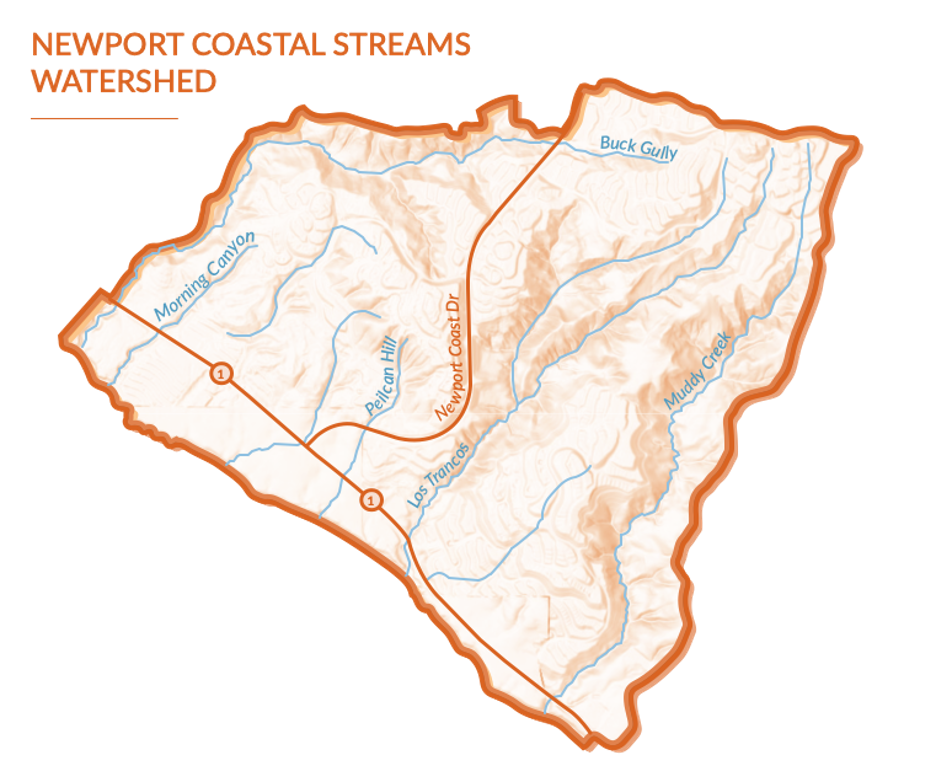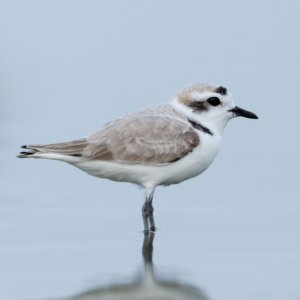Watershed Appreciation – Get To Know The Newport Coastal Streams Watershed
February 23, 2023

From its breathtaking beaches to its scenic mountains, Orange County is made up of 11 watersheds. The Newport Coastal Streams Watershed is the eighth in a series of blogs that showcase the wonders of each of these wonderful watersheds. If you’re new to the concept of watershed appreciation, our What is A Watershed? page is a great place to get started. Learn more and find out which watershed you live in by visiting our interactive map.
Rainwater is an asset! However, if it gets contaminated with pollutants, it can harm our local creeks, rivers, and the ocean. That’s why it’s up to all of us to do our part in protecting OC’s watersheds. Simple actions such as picking up after your dog, throwing away food wrappers, properly maintaining your sewer lateral, and disposing of cigarette butts in a closed trash bin help prevent this waste from flowing untreated through storm drains into our waterways.
No matter if you’re sunbathing at Little Corona del Mar Beach or hiking at Crystal Cove State Park, you’re enjoying the Newport Coastal Streams Watershed’s resources. From unique features and recreational opportunities to pollution prevention and stormwater resources, let’s take a deep dive and get to know the Newport Coastal Streams Watershed!
WONDERS OF THE NEWPORT COASTAL STREAMS WATERSHED
Unique Features
The Newport Coastal Streams Watershed covers over 14 square miles and supports thriving marine life in the Irvine Coast Area of Special Biological Significance (ASBS), Robert E. Badham ASBS, and Crystal Cove State Marine Conservation Area. These marine protected areas off the coast of Crystal Cove State Park contain giant kelp forests which boast thriving underwater ecosystems. Additionally, about 8 square miles of land in the watershed cannot be developed due to mountainous slopes and protected areas like Crystal Cove State Park which hosts plentiful plant and animal life. Conservation plans such as the Natural Community Conservation Plan and the Habitat Conservation Plan (for the Laguna Coast Wilderness Park and the Newport Beach, Irvine Coast, and Laguna Beach Marine Life Refuges) serve to inform how areas within the watershed are developed to avoid, minimize, and compensate for impacts to wildlife.
Entirely located within the City of Newport Beach, only about a quarter of the watershed is urbanized with streams like Buck Gully, Muddy Canyon, and Moro Creek draining to the ocean. We can all commit to protecting this watershed’s unique areas.
Wildlife & Plants
The Newport Coastal Streams Watershed is home to an abundance of plant and animal species. While exploring Crystal Cove State Park you’re likely to see hermit crabs and Spanish shawl nudibranchs filling tidepools on the shore, and fuschia-flowered gooseberry and monkeyflower along the trails. If you venture through the 1,100-acre underwater kelp forests off the coast, you may see leopard sharks and bottlenose dolphins roaming. And if you’re lucky, you may spot a Federally threatened snowy plover too! Marine and terrestrial species alike flourish in this coastal watershed.

Snowy Plover
Recreation
The Newport Coastal Streams Watershed has terrific outdoor recreation opportunities for a wide array of activities like hiking, camping, biking, scuba diving, sunbathing, ball sports, and bird watching. Visitors and locals alike enjoy this watershed’s recreational areas, including:
- Buck Gully Reserve – Whip out those hiking shoes! Miles of trails wind through this protected and lush wilderness in Newport Beach. Walk, run, or bike along these trails as you admire the stream and protected plant and animal species. To protect native wildlife routines, dogs aren’t allowed but the rest of the family can have a terrific time wandering this scenic terrain!
- Coastal Peak Park – Lace ‘em up! This City of Newport Beach park has a baseball diamond, basketball court, and playground for all to enjoy. There is also a sheltered area with picnic tables to savor a yummy meal after playing some ball.
- Crystal Cove State Park – Get ready to explore! This California State Park has 2,400 acres of backcountry wilderness to discover on foot or by bicycle. If you’re more of a beach person, sunbathe on 3.2 miles of gorgeous sand by the ocean and admire the tidepools filled with aquatic life! Feel free to venture out on paved areas with your dog but keep them away from the beach and backcountry (except service animals) to protect waterways and wildlife. Divers can roam the kelp forests off the coast and admire the incredibly diverse plant and animal life! The park has so much to do that you’ll have to come back multiple times to check everything off your list!

Crystal Cove State Park
- Little Corona del Mar Beach – Sandcastles galore! Bring the whole family to this small and calm paradise which is protected from swells and surf. This small beach is flanked on both sides by rocky reefs that are breathtaking to see via diving or snorkeling. In addition, this is one of the few beaches in OC where you don’t need to traverse stairs to access it, making it more accessible for people with all abilities. Don’t forget your sunscreen!

Little Corona del Mar Beach
- Moro Campground – Pack your bags! With 57 family campsites (27 RV and 30 “low impact” spots) that have picnic tables, restrooms, and showers available, you can enjoy the beautiful ambiance while camping. Feel free to bring your furry companion with you, but they must remain on a leash and are not allowed on the beach or in the backcountry. Make a reservation to secure your spot!
Water Quality
The Santa Ana Regional Water Quality Control Board works with the City of Newport Beach to preserve the Newport Coastal Streams Watershed. They enforce Municipal Separate Storm System (or MS4) Permit standards to keep our waterways healthy. In this watershed, H2OC is keeping its eyes on pollutants like indicator bacteria, a water quality metric for the possible presence of human and animal waste. Portions of Buck Gully Creek and Los Trancos Creek (Crystal Cove Creek) had bacteria levels that caused them to be listed as impaired waterbodies in 2006.[1] Due to aggressive actions taken by the City of Newport Beach and the water quality authorities, bacteria levels have been significantly reduced over the last 17 years.
Some of the ways water quality authorities helped reach their bacteria level goals include:
Nature-based Solutions
By adding native plants and restoring habitats, these projects help absorb pollutants and prevent runoff from flowing into the storm drain system.
- Pacific Coast Highway Swale Project (Caltrans, Orange County Coastkeeper)
- Morning Canyon Stabilization Project (City of Newport Beach)
- Buck Gully Stabilization and Water Infiltration Project (City of Newport Beach)
Diversions
Diversion projects build the infrastructure to take runoff that would normally go untreated directly into our waterways and instead divert it to a treatment facility.
- Los Trancos Diversion Project (California State Parks)
- Muddy Creek Diversion Project (California State Parks)
Irrigation System Upgrades
By installing hundreds of smart evapotranspiration (ET) controllers which adjust watering amounts and schedules based on the climate and upgrading thousands of stream irrigation emitters, overwatering and runoff pollution are dramatically reduced. This helps prevent pollutants like dirt or pesticides from running off into the storm drain system. Learn more about overwatering at our Overwatering Is Out page.
- ET Controller Program (City of Newport Beach)
Protecting our watersheds is vital not only for the plants, animals, and people that live in them, but also for their impact on the ocean. The Newport Coastal tributaries like Buck Gully, Los Trancos, and Muddy Creek all flow directly into the Pacific Ocean and protected marine areas, so it’s important to prevent runoff pollution no matter where you are in the watershed. The County of Orange, Orange County Flood Control District, and City of Newport Beach are committed to protecting water quality in the Newport Coastal Streams Watershed for generations to come.
Protecting the Newport Coastal Streams Watershed
Bacteria is the most prevalent pollutant in the Newport Coastal Streams Watershed. Below are ways you can help prevent pollution to keep the watershed healthy:
Properly Dispose of Animal Waste
- Bring dog waste bags with you and pick up waste immediately.
- Tie dog waste bag shut and place in a covered trash can.
- Pick up pet waste in your yard too!
Prevent Littering
- Close the lids on any open garbage cans.
- Throw away all trash in a closed bin.
Maintain Your Property
- Properly dispose of cooking grease and only flush toilet paper down the toilet to prevent backups within your sewer lateral lines.
- Hire a licensed plumber to evaluate your sewer lateral or septic system and determine a maintenance schedule for your property.
- Repair or replace worn-out or damaged laterals as soon as possible.
More Ways to Appreciate Orange County’s Watersheds
There are many ways to get involved in your local community and appreciate your local watershed:
- Explore your watershed and report water pollution. While you’re visiting Orange County’s creeks, trails, and coastline, make observations about water quality conditions. If you see anything abnormal (such as high numbers of dead fish or fowl, overwatering, trash in the gutter, or other signs of pollution), report it by visiting our Report Pollution page.
- Connect with area watershed organizations through local events. Join H2OC, other organizations, and your neighbors who are working to protect and restore our creeks, rivers, bays, and ocean. Find events in your area.
- Spread the word. To protect our waterways, share your knowledge about preventing water pollution and encourage others to do the same. You can even involve your kids by teaching them about watersheds and pollution prevention through our Stormwater 101 for Students page.
- Learn more. Visit our What is a Watershed? page and our Tips for Protecting Your Watershed brochure.
[1] In accordance with the Clean Water Act, a formal regulatory process.